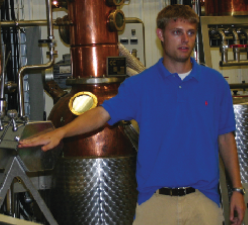Thanks to the University of Minnesota, wine grapes can thrive in some of the coldest climates in North America (and beyond). In this issue, two winemakers discuss making wine with the Minnesota-bred, cold-hardy hybrid, La Crescent.
 Scott Prom, Winemaker at Shelburne Vineyard in Shelburne, Vermont. Scott’s interest in wine started in 1985 while living in Seattle and working for airplane manufacturer, the Boeing Company where he started making his own wines with the Boeing Employees Wine and Beer Makers Club. Originally from Wisconsin, Scott and his family moved to Vermont in 1996. After experiencing winemaking withdrawal, Scott hooked up
Scott Prom, Winemaker at Shelburne Vineyard in Shelburne, Vermont. Scott’s interest in wine started in 1985 while living in Seattle and working for airplane manufacturer, the Boeing Company where he started making his own wines with the Boeing Employees Wine and Beer Makers Club. Originally from Wisconsin, Scott and his family moved to Vermont in 1996. After experiencing winemaking withdrawal, Scott hooked up
with Ken Albert in 1998 and the two began the relationship that has resulted in Shelburne Vineyard.
Our La Crescent is a semi-dry style. We played around with a few different styles in the past, sometimes going a little drier and other times a little sweeter, but I think it does like to have some sweetness in it.
In the vineyard, we trellis the grapes on high cordon trellis as opposed to vertical shoot positioning (VSP). We sort of defaulted into high cordon to keep the critters away, and it makes for easier picking. However, we may experiment on VSP in the future for labor cost, but I don’t think anybody’s got La Crescent all figured out yet.
At harvest, we pick the grapes based on the sugar. The grapes get very loose when they are ripe — around 23 °Brix — and if you let them hang too long the grapes literally start falling off the vine. We pick the grapes and live with the acid, whatever it is, and it is often up around 13 to 14 grams per liter. This is why La Crescent wants to be a little semi-dry. You should be very careful about balancing acid if you want to make a very dry wine.
In the winery, we start with a standard crush. We take off all the stems and press right away, squeezing pretty hard. We don’t have enough quantity to experiment much yet. Our largest vintage of La Crescent — this year — was only 400 gallons (1,514 L), so we are making it all into the semi-sweet style.
When we ferment we shoot for right around 60 °F (15 °C), targeting a drop of 1 °Brix per day. We’ve tried out some designer yeasts, but Epernay II is our go-to strain. We’ve had good luck with it, it’s reliable and you can stop it with some residual sugar. When we get the wine down to 2%, we rack it and then chill it to about 40–45 °F (4–7 °C) to stop the fermentation. We then stabilize and fine with bentonite. We cold stabilize down to 28 °F (-2 °C) for two weeks to settle out the tartrates — and we get a lot of tartrates. After that, the wine is pretty clear, so we bring it up to 50 °F (10 °C) and bottle it.
We work with Louise Swenson as well as La Crescent and we have experimented with blending both grapes. The general consensus we have found is that La Crescent stands on its own, but the Louise Swenson benefits from a small percentage of La Crescent. The Louise Swenson sort of gets lost when there is a lot of La Crescent. In other wines, I would say that small percentages of La Crescent can be a good blending wine to add some sweetness, body and interest.
As for aging, for the most part La Crescent is ready to go once it is past the bottle shock stage. They are very fruit forward wines. We bottle them within a year and give them a month to rest for bottle shock, then they are ready to go.
If you want to experiment with La Crescent at home, keep in mind that depending on the season and care in the vineyard it can be very high in acid and you can harvest too high. If you let it ferment too dry you will most likely have something out of balance — an acid bomb. We have not had to mechanically bring down the acid, but it can be done if you have to, however the goal is to let the wine be itself — whatever you harvest at. If it’s high, leave it high but leave some residual sugar. If you want to make it dry, drop the acid. It has the acid to make a nice icewine if you could let it hang, but that would be tough because, as I mentioned before, the grapes tend to fall off when they are ripe.
 Kolin Brighton, Winemaker at Cedar Ridge Vineyards in Swisher, Iowa. Kolin started out the production manager at Cedar Ridge during harvest in 2009. Under the guidance of Cedar Ridge’s owner, Jeff Quint, he is now in charge of all of Cedar Ridge’s winery and distillery operations, including vineyard/harvest, fermentations, barreling and packaging.
Kolin Brighton, Winemaker at Cedar Ridge Vineyards in Swisher, Iowa. Kolin started out the production manager at Cedar Ridge during harvest in 2009. Under the guidance of Cedar Ridge’s owner, Jeff Quint, he is now in charge of all of Cedar Ridge’s winery and distillery operations, including vineyard/harvest, fermentations, barreling and packaging.
We make our La Crescent in an off-dry or semi-dry, fruit-forward style, which leans more towards the tropical fruit profile. A lot of our customers are becoming used to the off-dry style, and we like that the wine fills the gaps between the sweet and dry wines.
In the vineyard, we harvest the grapes as late as possible — not as late as our dessert wines, but only about a week earlier. We try to let it hang as long as we can to reduce the vegetal and green flavors. Last year we harvested at 20.5 °Brix, the TA was 1.13 and the pH was 3.17. We have it on a high-wire trellis and do shoot thinning and cluster thinning. If you’re going to try growing La Crescent, know that the vines will grow very quickly and get very dense if you don’t keep up on the thinning.
In the winery we follow the same process as we do with all whites. The grapes are crushed and pressed immediately after harvest, the juice is cold settled in a cool chiller for two days. We then rack it and perform a cold/cool fermentation — we don’t let it get higher than 69 °F (21 °C) unless the specific strain produces a desirable ester at a higher temperature. We typically ferment with Lalvin 71B because it chews up a bit of the extra malic acid and brings up the pH naturally. I also use oak-specific enzymes and yeast-derived nutrition and to preserve some of the grape’s natural aroma and varietal flavors.
We haven’t blended anything into to our La Crescent, but we have blended extra La Crescent into other neutral whites. We planted it in 2003 but didn’t make a vintage until 2009. Until we got it in the winery we thought it was just going to be average, but the results were well above our expectations and we haven’t added anything to it.
 Scott Prom, Winemaker at Shelburne Vineyard in Shelburne, Vermont. Scott’s interest in wine started in 1985 while living in Seattle and working for airplane manufacturer, the Boeing Company where he started making his own wines with the Boeing Employees Wine and Beer Makers Club. Originally from Wisconsin, Scott and his family moved to Vermont in 1996. After experiencing winemaking withdrawal, Scott hooked up
Scott Prom, Winemaker at Shelburne Vineyard in Shelburne, Vermont. Scott’s interest in wine started in 1985 while living in Seattle and working for airplane manufacturer, the Boeing Company where he started making his own wines with the Boeing Employees Wine and Beer Makers Club. Originally from Wisconsin, Scott and his family moved to Vermont in 1996. After experiencing winemaking withdrawal, Scott hooked up
 Kolin Brighton, Winemaker at Cedar Ridge Vineyards in Swisher, Iowa. Kolin started out the production manager at Cedar Ridge during harvest in 2009. Under the guidance of Cedar Ridge’s owner, Jeff Quint, he is now in charge of all of Cedar Ridge’s winery and distillery operations, including vineyard/harvest, fermentations, barreling and packaging.
Kolin Brighton, Winemaker at Cedar Ridge Vineyards in Swisher, Iowa. Kolin started out the production manager at Cedar Ridge during harvest in 2009. Under the guidance of Cedar Ridge’s owner, Jeff Quint, he is now in charge of all of Cedar Ridge’s winery and distillery operations, including vineyard/harvest, fermentations, barreling and packaging.


